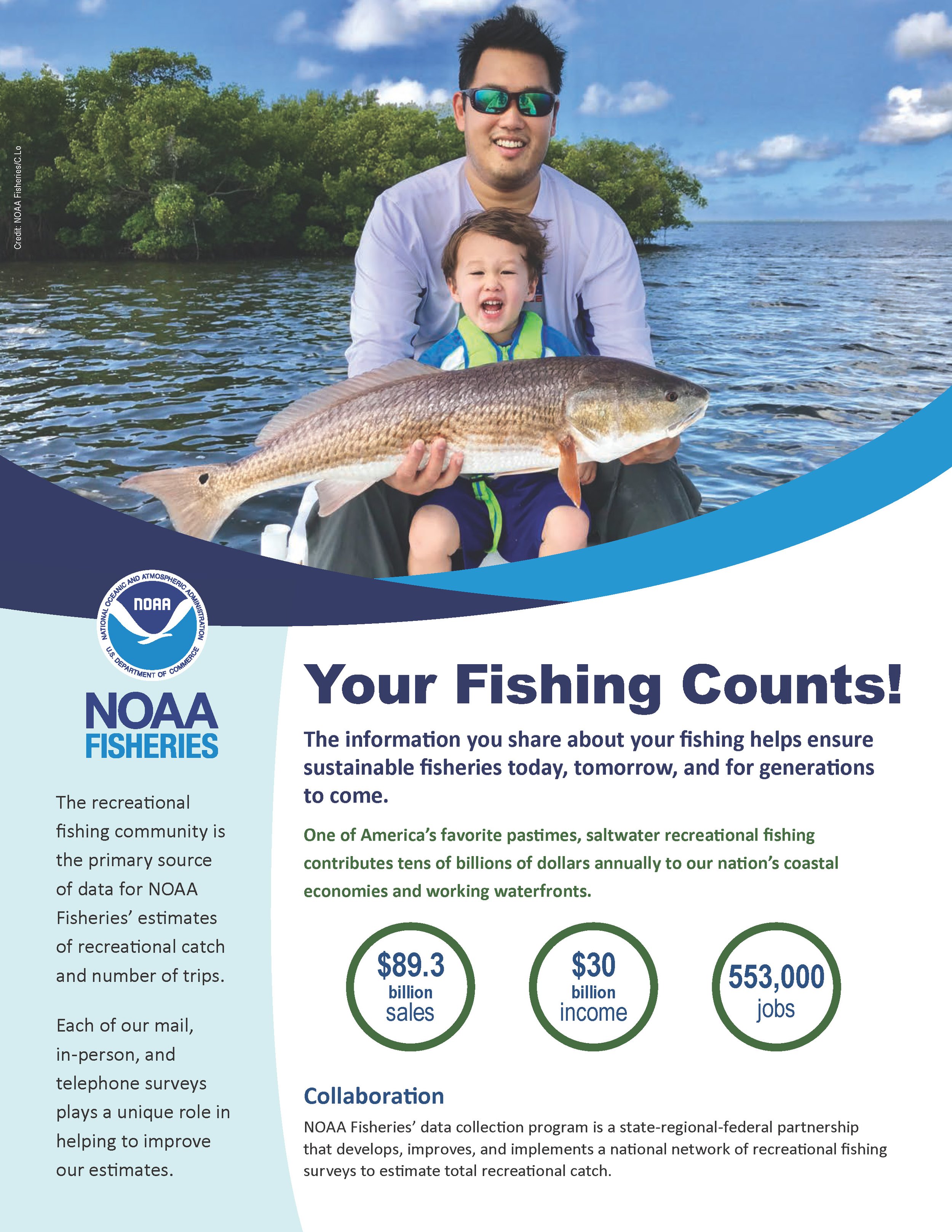Recreational Fishing Data in the Mid-Atlantic
This page provides an overview of recreational fishing data collection in the Mid-Atlantic, conducted through the state-regional-federal Marine Recreational Information Program. Unless otherwise noted, all links on this page lead to the NOAA Fisheries website.
Overview
Through the Marine Recreational Information Program (MRIP), NOAA Fisheries and its state, regional, and federal partners use in-person, telephone, and mail surveys to measure the number of trips saltwater anglers take and the number of fish they catch. The large-scale surveys administered through MRIP provide one of the only sources of regionally consistent recreational data and long-term trend information covering many species. When combined with other information such as commercial catch data, biological research, and observer data, recreational catch and effort estimates help fisheries scientists and managers keep our stocks sustainable.
Recreational Fishing Data Collection
In the Mid-Atlantic region, MRIP administers three general surveys to collect data to produce general recreational catch and effort estimates:
The Access Point Angler Intercept Survey (APAIS) is an in-person survey conducted at marinas, boat ramps, beaches, fishing piers, and other publicly accessible fishing sites. Trained samplers from state agencies interview anglers as they complete their fishing trips and collect information about the location, mode (e.g., shore, private or rental boat, or for-hire vessel), and general area fished, as well as number, size, weight, and species of fish caught (kept or released).
The Fishing Effort Survey (FES) is a mail survey that collects information about fishing activity, or effort, from households in coastal states. The FES replaced the Coastal Household Telephone Survey in 2018.
The For-Hire Survey (FHS) is a telephone survey that collects effort information from for-hire (party/charter) vessel representatives. Data from the FHS is used to develop estimates of the number of angler fishing trips taken on for-hire vessels that are not required to submit federal electronic Vessel Trip Reports (VTRs), such as those that only hold state permits. To produce complete MRIP for-hire effort estimates, the FHS estimates are then added to the VTR census counts of angler trips for the federally permitted vessels.
The APAIS survey generates catch rate information (average numbers of species caught per trip), and the FES and FHS/VTRs generate effort information (number of trips). APAIS data are also used to apportion effort between areas (inland, ocean near-shore, ocean beyond 3 miles) and account for out-of-state fishing activity. This information is combined to generate total catch estimates.
In addition, MRIP administers the Large Pelagics Survey, a specialized suite of three surveys (intercept, telephone, and biological) that produces catch and effort estimates for large pelagic and highly migratory species.
Learn More:
Recreational Catch Estimates
Click image to expand
MRIP uses data collected from the surveys described above to produce estimates of total recreational catch. While the actual statistical process is complicated, in essence these estimates are generated by multiplying catch rate (the average number of a particular species caught per fishing trip) by effort (the total number of fishing trips taken).
NOAA Fisheries staff practice extensive quality assurance and control measures before publishing the estimates. This includes checking for errors in data entry and investigating any unusual changes in trends for high-interest, rare-event, and federally managed species.
Learn More:
Survey Design and Statistical Methods for Estimation of Recreational Fisheries Catch and Effort (PDF)
How to Access Recreational Data
There are several ways to access the information used to estimate recreational fishing activity. You can use the MRIP query tool to filter catch and effort data by time series, geographic area, species, mode, and other characteristics. You can also download full datasets.
Get Recreational Data:
Recreational Fishing Data and Statistics Queries Landing Page – a searchable database of catch and effort statistics
Recreational Fishing Data Downloads – full datasets for more advanced data queries/analysis
Fisheries Management and Recreational Fishing Data
Click image to expand
The recreational fishing data MRIP produces is critical to inform and support the federal fisheries stock assessment and management processes. The total catch estimates produced by MRIP are combined with other information including commercial catch, biological information, and observer data to help scientists assess the health of fish stocks. Through a public process that includes angler input, fisheries managers use this information to set regulations that strive to balance access to the resource while ensuring its sustainability.
Other Useful Resources
MRIP Strategic Plan (PDF)
Contacts
MRIP
For general questions about MRIP, contact:
Sarah Lazo, NOAA Fisheries, MRIP Communications Specialist, sarah.lazo@noaa.gov, (301) 427-8181
Council
For questions pertaining to how the Council generally uses recreational data in the management process, contact:
Jason Didden, Fishery Management Specialist and MRIP staff lead, jdidden@mafmc.org, (302) 526-5254
Mary Sabo, Communication and Outreach Coordinator, msabo@mafmc.org, (302) 518-1143
For questions on how the Council uses recreational data for specific species, contact the species leads at the bottom of this page: https://www.mafmc.org/staff.




